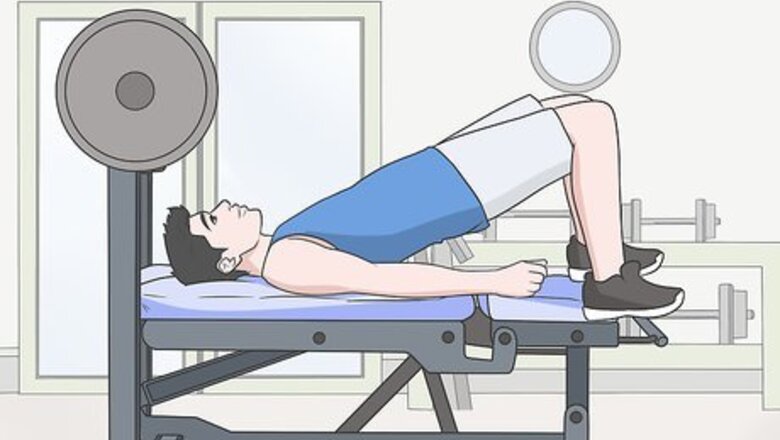
views
Using Proper Technique to Bench More

Start off with your feet on the bench, your pelvis high, and your shoulders sinking down into the bench. You want your shoulders to start off bearing most of the weight to ensure good technique. This will help promote better posture when you finally lift.
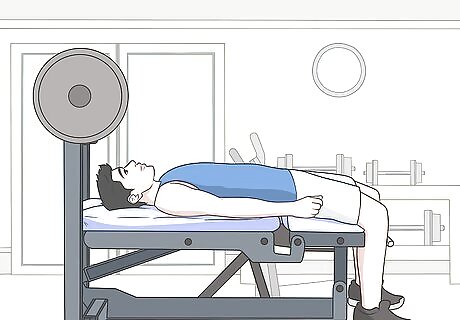
Lower your feet to the ground, your butt to the bench, all while maintaining the shoulder contact with the bench. This should produce an arch in your back, meaning more torque that you can bring to the exercise. Keep your neck resting comfortably on the bench at all times.

Lock the bar with a closed grip, making sure to use your thumb. Lock your thumb under the bar. A good rule of thumb (get it?) is to have it resting on top of your index finger.

Learn where to position your hands for maximum load-bearing capacity. Depending on your height and the length of your arms, position your hands on the bar so that your forearms are perfectly vertical when the bar is brought down to the chest. Many people achieve this by gripping the bar a little wider than shoulder-length apart. The wider the grip, the more you tend to activate the chest muscles. The tighter your grip, the more you tend to activate your triceps muscles. Do what feels comfortable. People with longer arms will probably feel more comfortable gripping the bar farther apart than people with shorter arms.

Move your shoulders side to side to maintain maximum contact with the bench. When benching, you push off — at least partly — with your shoulders. If your shoulders are hanging off the side of the bench or aren't centered, you're going to lose that fulcrum and your ability to bench much more weight will go down.
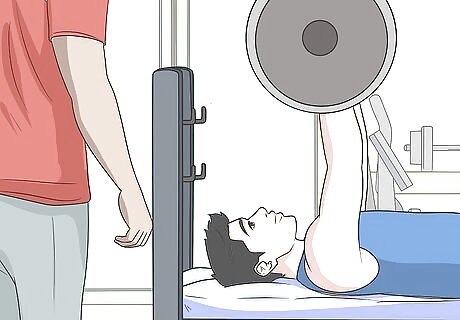
Always use a spotter. With a spotter, the fear that you won't be able to max out usually falls away: If you struggle with a heavy weight, your spotter will be there to bail you out. This is an important psychological factor. You should always be pushing yourself above your current plateau in order to bench more weight, and a spotter makes that journey more safe.
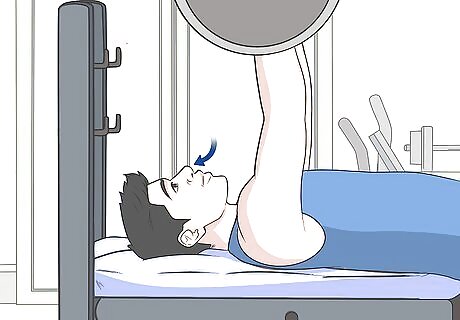
Practice proper breathing technique. Inhale at the top of your bench. After you've gotten nearly up to the top of your rep, exhale. Inhale again at the top and repeat the technique for maximum power. Remember, proper breathing sends oxygenated blood to your muscles.
Leveraging Other Strategies to Bench More
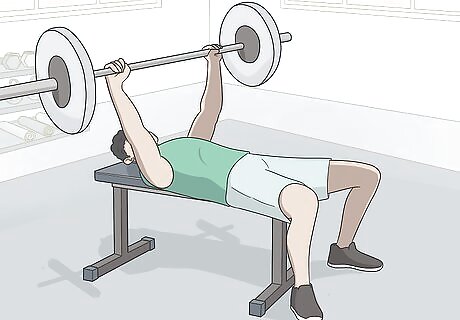
For bench press in particular, lower your reps and increase your weight. For heavy power lifts, such as bench press, 5 sets of 5 reps works really well for boosting your ability to lift more. Competitive weight lifters will even do sets of three, two and one reps in order to max out.
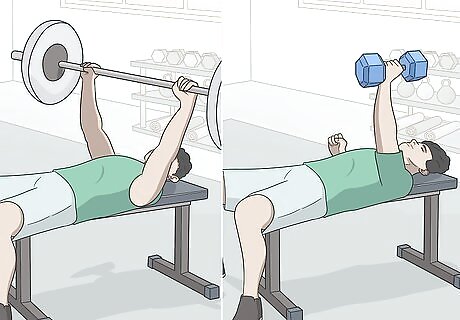
Do your heavy lifting first, and then finish off with mid-range isolation exercises. Start your routine off with the bench press. Again, low reps and higher weight are best. After you've done the heavy lifting, finish off your chest, tri, and shoulder exercises with lower weights and higher reps: 10-15 reps per set works really nicely.
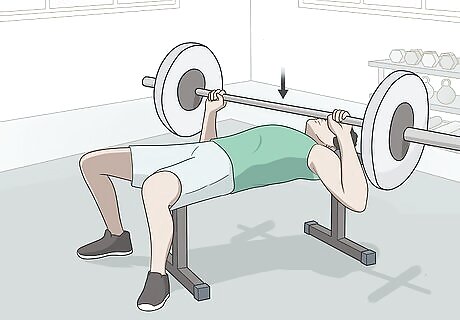
Lower the bar just above the bottom of your chest without letting it hit your chest. Too many people let the bar bounce off their chest. While this usually isn't harmful to your chest, it keeps your triceps from staying activated and working during the whole rep, thereby resulting in less strength. Think of it this way. Bouncing the bar off your chest on the downstroke is like putting training wheels on your bike during the most wobbly stretch of the ride. If you're trying to become a faster biker, you'd do better to ditch the training wheels altogether.
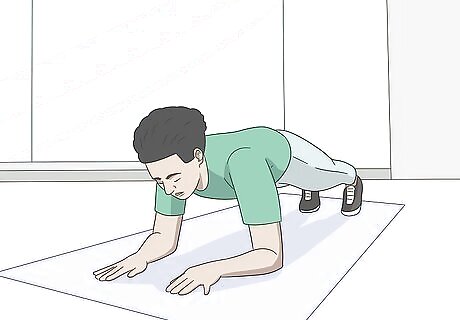
Practice your pushups and other triceps workouts. Strong triceps are the not-so-secret ingredient to a stronger bench. The pushup is a much more natural movement that gives your shoulder blades a degree of movement not afforded by simple bench press. Pepper your bench press with triceps workouts such as dips, skullcrushers, lying triceps extensions, triceps pushdowns, and a whole host of other exercises.
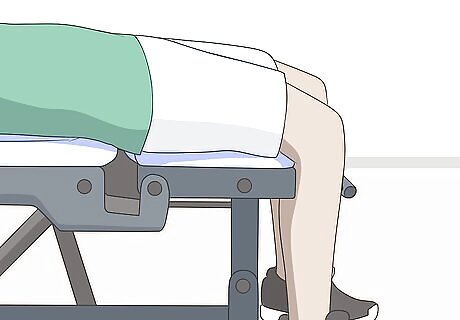
Mind your glutes. With your back arched, your shoulders activated, and your feet firmly planted on the ground, your glute muscles become especially important. Activate them when benching. With a firm, stable bum, your body will be able to reinforce the torque your chest, triceps, and shoulders are pumping into the bar, thereby strengthening your overall benching ability. Similarly, keep your glutes on the bench when pressing. Don't lift your butt into the air. This is not only dangerous — it shifts unnecessary strain onto your neck — but also weakens your overall bench.
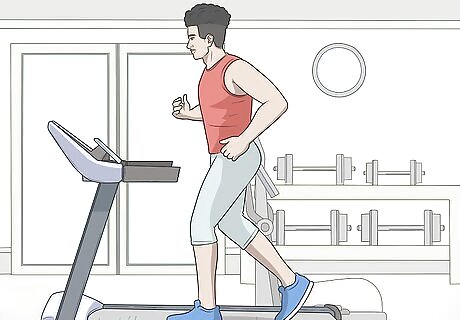
Chill on the cardio. You want your calories for your body to build bigger/stronger muscles and eventually be able to handle your ideal bench weight. If you must do cardio, eat food to replace the calories lost.
Mastering Diet and Lifestyle Considerations

Diet, diet, diet. Eat 500 calories above your BMR + any extra calories you burn during the day. If you eat too much you'll gain fat as well as muscle. You'll want to look as lean as possible. You'll want to eat 1 gram (0.035 oz) of protein per lean body mass each day. To find out what your body mass is, get a body fat measurement. Let's say your body fat percentage is 10%. That means you have 90% lean body mass. If you weigh 150 lbs that is 150 x .90 = 135 lbs of lean body mass, so you should eat 135 grams (4.8 oz) of protein every day.
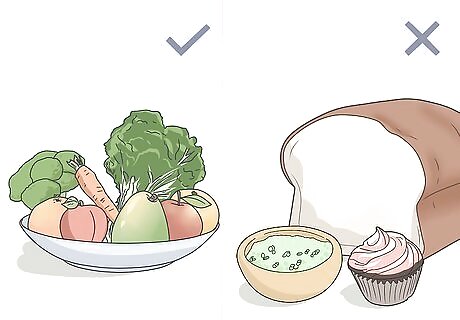
Be able to distinguish the good carbs from the bad. Carbohydrates have gotten a bad rap in recent years. Tons of fad diets proclaim their inherent ghoulishness and treat them like the boogeyman. In fact, carbohydrates are the building blocks of fuel for your body, and complex carbohydrates in particular can be good for your body, as they are metabolized a lot less quickly than simple carbohydrates. Stick mostly to healthy carbs, such as legumes, veggies, fruits, and whole grains. Stay away from less healthy carbs, such as processed foods, white breads, sugars, and fried foods.

Get good fat into your diet. Like carbs, fats have been excoriated in recent years. The key is understanding what fats to put into your body. Whereas saturated fats — coming from chips and candy bars — and trans fats — coming from frozen or "fast" foods — aren't good for you, unsaturated fats and fatty acids are actually healthy when consumed in moderation. Examples of unsaturated fats include: nuts, vegetable oils, olive oil, avocado Examples of fatty acids include: soybean oils, fish (mackerel, sardines, salmon, etc.), flaxseed, walnuts

Spread out your meals instead of eating one or two times a day. Find out your calorie requirements and estimate how many calories you burn during a day. Then shoot to exceed that calorie threshold in order to build muscle. Instead of eating one or two big meals during the day, try five or six smaller meals which include pre- and post-workout snacks.

Sleep. Sleep is not only essential for feeling relaxed and ready to hit the day in the morning — it's also essential for helping your body's muscles grow. Researchers have found that during high-quality REM sleep, the body repairs tissue and circulates human growth hormone, or HGH. So it's very important to carve out 7 to 8 hours of quality sleep for yourself every day in order to let your body rebuild its muscles.
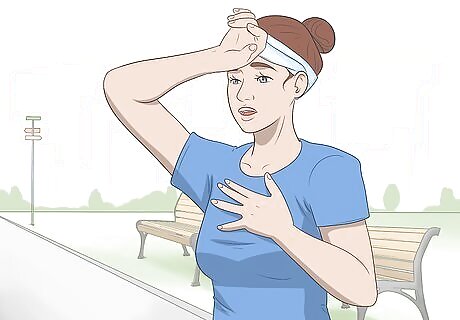
Don't overtrain. Probably one of the most important but most overlooked lifestyle factors, overtraining keeps you from cementing the muscle gains that you would have otherwise made. Depending on the intensity of your workout, give your chest and triceps one to two days break in between workouts. During that time, it's important to work out other muscle groups, so make sure you give them the attention they deserve.



















Comments
0 comment